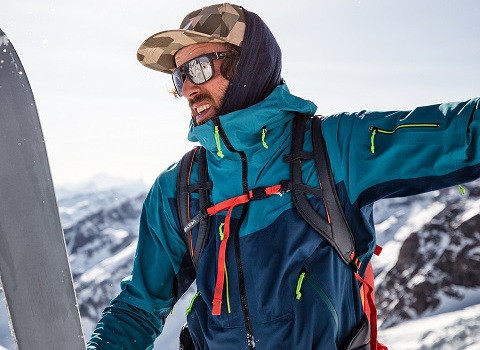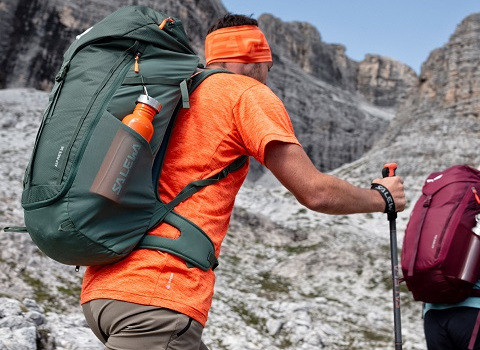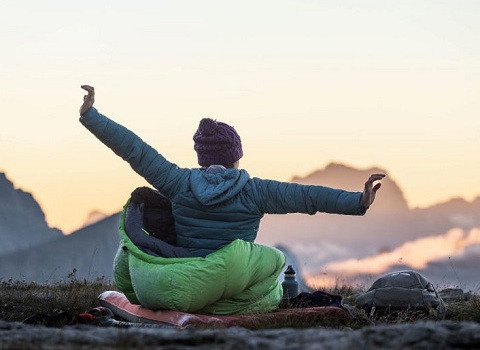expert advice / Mountaineering / Ski-Mountaineering
HOW TO DRESS IN LAYERS FOR MOUNTAIN ACTIVITIES
1. How to dress in layers for mountain activities
When we’re active in mountain environments, the clothes we wear play a key role not only in keeping us comfortable but also in keeping us safe from the elements if the situation becomes more challenging. The best way to dress for outdoor activities of any kind is to adopt the commonly accepted approach of layering, or the 3-layer system as it’s also known.
What is the 3-layer system?
- Base layer: For wicking perspiration away from the body
- Middle layer (or mid layer): For insulation to keep you warm
- Outer layer (or shell): For protection from wind, rain, snow etc.
2. Why is it important to dress in layers?
Weather protection layers are great at blocking out wind and rain but are consequently not breathable enough to maintain a pleasant body temperature while moving about. Insulation is important for the cold but so is getting rid of perspiration so that we are not wet and cold. So adopting different layers for different functions is the best approach to creating a clothing system that’s both comfortable, protective and warm.
The more different layers of clothing we wear, the more adaptable we can be to changes in weather conditions or changes in tempo. We can remove insulation layers, for example, but retain a weatherproof shell. Or strip down to our baselayer when it’s warmer and we’re moving fast. But remember it’s easy to take layers off if you’re too warm but you can’t add layers that you don’t have with you.
3. How to dress in layers for skiing?
Dressing in layers of skiing follows along similar lines as winter hiking, except that intensity levels tend to be greater when skiing, and ski-appropriate materials and features are beneficial.
Bottom:
Ski pants are often insulated as well as offering wind and water protection. Durable materials are best as wear and tear is high in an activity that involves wooden planks with metal edges!
Base layer: In cold temperatures you can also wear thermal leggings like stretch merino wool tights. They are soft next to the skin, breathable and wick moisture effectively away from the skin so you aren’t cold when stopping to catch a lift back up. They are also insulating and odour inhibiting. Long underwear made from polyester is another option.
Top:
Base layer – breathability is key here, as is wicking function. Ski base layers can be thin or slightly heavier weight depending on the prevailing temperatures. But skiing is a high-octane activity, and so sweat needs to be transported away from the skin, or else you will quickly become cold on the chairlift or in the cable car. Merino wool remains insulating even when wet, so it’s a great option for ski base layers. A raised collar and zip provide effective adaptability to increase or decrease insulation. Neck gaiters are also useful for added warmth and wind protection around the chin/neck area.
Mid layer – A fleece jacket offers effective insulation and wicking performance as a midlayer for skiing. It retains its insulation when wet and is also a good choice on days when it’s snowing hard, or if you’re ski touring and are likely to sweat more. On very cold, dry days a down jacket makes the perfect mid layer. Down insulation is light, highly insulating and packs down small when you no longer need it.
Outer layer – Ski jackets often have a layer of insulation in them or are lined in fleece, so if that’s the case, you might want to consider a thinner mid layer. Wind protection is key here as there is always wind when skiing – either climatic or from your own movement. Waterproof performance is recommended but you could get away with a durable water repellent (DWR) finish if you only tend to ski in good weather. Make sure your jacket has a hood that is compatible with a helmet so that you can protect your head in snowstorms. And ventilation adaptability, like pit zips or back ventilation slits are also effective at regulating fluctuations in body heat output – especially when ski touring. A ski jacket might also feature a snow skirt to prevent snow or powder from making its way up into your torso area.
1. How to dress in layers for outdoor activities
2. Why is it important to dress in layers?
A winter hiking layering system might look like this:
Bottom:
In winter in particular, the layering system also applies to your legs. Long underwear or leggings
Winter hiking shell pants can be insulated or not, but they need to be fully waterproof. Consider also features like zips at the bottom of the leg to adapt over hiking boots, or built-in gaiters for added protection.
Warm and comfortably cushioned socks are also a must.
Top:
Base layer – a long-sleeved base layer, ideally made from merino wool for its insulating and odour regulating properties and effective breathability. A high collar with a short zip offers the option of increasing ventilation if needed while also covering the cold-sensitive neck area. In extremely cold weather, you might consider a mid-weight or heavy-weight base layer but remember that the layer against your skin has to perform a moisture wicking function.
Mid layer – a down-filled jacket offers the best warmth-to-weight performance of any insulation material. However, if the down gets wet, then it loses some of its insulation performance. So consider the weather conditions you are likely to come across when choosing your mid layer. Other insulation materials include polyester fleece, synthetic fibrefill, or even thermo-reactive wool/synthetic blends. In winter you might consider wearing a mid layer (primary) and carrying an extra insulation layer (secondary) in case of extreme cold or pauses in activity.
Outer layer – for winter hiking, it’s worth investing in a 3-layer hardshell jacket, for full weather protection. The extra layers of waterproof technology will keep you drier for longer, which is important at a time of year when precipitation can be very persistent. A well-fitting adjustable hood and cuffs also increase protection, and comfort.
Related Topics
HOW TO LAYER FOR SKI MOUNTAINEERING
Ski mountaineering is an intense activity. Moving through the mountains in winter means that you need to take everything that you need with you.
HOW TO PACK AND ORGANIZE A HIKING BACKPACK
A well-packed backpack can make all the difference to enjoying your time in the mountains – whether day trip, hut-to-hut adventure or a week trekking in the backcountry with a sleeping bag and tent.
HOW TO CHOOSE A SLEEPING BAG
Having a cosy night’s sleep can make a huge difference to the enjoyment of any night out camping or bivvying, so it’s important to spend some time carefully considering what sleeping bag is the right choice for the activities you’ll be undertaking and the environment you’ll be in.
4. How to dress in layers for hiking
As with all hiking clothing options it’s important to consider the climate you’ll be in and the likely weather conditions you’ll encounter. But here are some guidelines for what to wear
A summer hiking layering system might look like this:
Bottom:
Thin hiking pants with DWR (durable water repellent) finish for moisture protection, plus a pair of waterproof overtrousers in your backpack, in case it starts to rain persistently. In summer there is probably less need for insulation on your legs, but bear in mind that at higher altitudes, summer temperatures can still be surprisingly cold. In hotter climates, shorts will also suffice, but remember to bring weather protection, just in case.
Top:
Base layer – ideally a thin base layer made from synthetic fibres that wicks moisture quickly and effectively away from the skin, or merino wool / merino wool blend, which is odour inhibiting, absorbent and lightly insulating, with a pleasant next-to-skin feel. You might also consider a base layer with built-in sun protection for hiking in hotter climates. Breathability and wicking performance are key here.
Mid layer – this could be a thin down or synthetic jacket, or a hybrid jacket in natural wool and synthetic insulation that offers some wind protection and some insulation while remaining breathable for more energetic hiking. It could also be a thin or medium-weight fleece jacket.
Outer layer - or shell jacket for full weather protection. Waterproof and windproof softshell jackets made with a special waterproof membrane like GORE-TEX® are essential for full protection from the elements in mountain environments. For summer hiking, this layer can be somewhat thinner and more packable.




